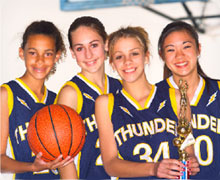Preventing and Treating Basketball Injuries
 Basketball is fun for everyone, from young kids to grown-ups. As with any sport, there is a risk of injury when you play basketball. Here are some tips to help you prevent injuries. If you do get hurt, this page also explains how to treat some of the more common injuries.
Basketball is fun for everyone, from young kids to grown-ups. As with any sport, there is a risk of injury when you play basketball. Here are some tips to help you prevent injuries. If you do get hurt, this page also explains how to treat some of the more common injuries.
Injury Prevention Tips
- Wear gym shoes that fit snugly, are non-skid and have high tops.
- Use a mouth guard, ankle braces and safety glasses.
- Warm up and stretch before each session.
- Use proper technique and follow the rules.
- Do not wear jewelry.
- Play on a clean, dry, safe surface.
- If you are injured, take the time needed to heal before you return to sports.
Ankle Sprains
Ankle sprains occur most often when you land on another player's foot. In most cases, the ankle turns inward. Pain around the bony bump on the outside of your ankle is normal. You may have swelling and/or bruising. Your ankle may feel unstable.
Treat ankle sprains with the R.I.C.E. method.
R.I.C.E. method
- Rest the injured area.
- Ice the injured area for 20 minutes every 2 hours.
- Apply a Compression wrap (like an Ace bandage) to reduce swelling.
- Elevate the injured area to a level above the heart.
Knee Sprains
Knee sprains can be caused by a sudden stop or change in direction. They can happen with or without contact from another player. Your knee may feel like it popped or gave out and may feel unstable after injury. The pain may be in one small spot or throughout the whole knee. Swelling may occur within the joint, feeling like pressure behind the kneecap or in the joint itself. Swelling may or may not be visible.
Treat knee sprains with the R.I.C.E. method. If your knee is very unstable, you have a lot of pain or your knee is swollen, popping or clicking, see a doctor to make sure you don't have serious ligament damage
Head and Face Wounds
Head and face wounds often occur due to a direct blow from another player. The eyes, mouth, chin and nose are easy to injure. Head and face wounds bleed a lot.
Apply direct pressure to the site of the injury to control the bleeding. Wounds that are jagged, gaping open, very deep or wide or won't stop bleeding may require stitches. In these cases, go to the emergency room right away.
Coaches, athletic trainers and players should make sure that clothing and the playing surface are cleaned well before play continues.
Concussions
Concussions can happen with or without a loss of consciousness, or being "knocked out." If your child or teen may have a concussion, they need to stop playing right away. They cannot return to practice or play in a game until they are evaluated and given a written note by a doctor or other licensed healthcare provider trained in the evaluation and treatment of concussions.
Some signs and symptoms of concussion are confusion; problems with vision, memory, speech or balance; change in behavior or personality; headache; upset stomach or throwing up; sensitivity to light or sound; and feeling more tired than usual.
Muscle Injury
Muscle injuries can happen from overuse or lack of flexibility. Some muscle injuries may come with swelling, bruising and a visible indent in the muscle.
Treat muscle injuries using the R.I.C.E. method. For a minor overuse muscle injury, also try light stretching.
Bruises
Bruises are caused by a direct blow or collision with another athlete.
Treat bruises using the R.I.C.E. method. Light stretching and use of the joints above and below the injury can help prevent stiffness and pain.
Jammed Fingers
It is common to jam a finger while playing basketball. Soak the hand in cold water for 20 minutes. You can protect the jammed finger by using medical tape to tape it to the next finger. This is called "buddy taping."
To Learn More
- Seattle Children's Orthopedics and Sports Medicine, 206-987-2109
- Your child's healthcare provider
